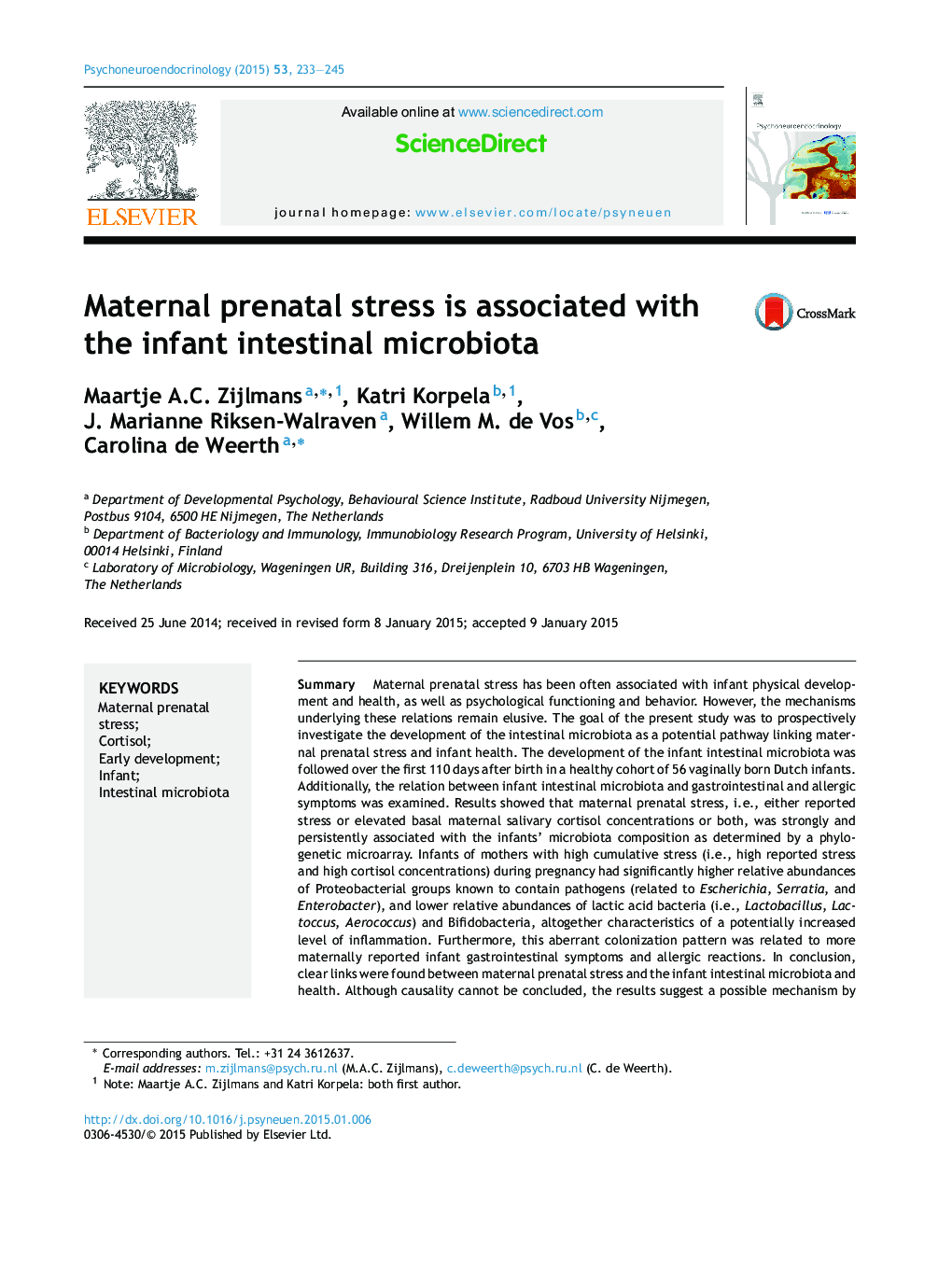| کد مقاله | کد نشریه | سال انتشار | مقاله انگلیسی | نسخه تمام متن |
|---|---|---|---|---|
| 6819150 | 547401 | 2015 | 13 صفحه PDF | دانلود رایگان |
عنوان انگلیسی مقاله ISI
Maternal prenatal stress is associated with the infant intestinal microbiota
ترجمه فارسی عنوان
استرس پس از زایمان مادر با میکروبیوتا روده نوزاد ارتباط دارد
دانلود مقاله + سفارش ترجمه
دانلود مقاله ISI انگلیسی
رایگان برای ایرانیان
کلمات کلیدی
استرس قبل از تولد مادران، کورتیزول، توسعه اولیه، نوزاد میکروبیولوژیک روده،
ترجمه چکیده
استرس پس از زایمان مادر اغلب با توسعه فیزیکی نوزاد و سلامت، و همچنین عملکرد روانی و رفتار همراه است. با این حال، سازوکارهایی که این روابط را پایه ریزی می کنند، درهم آمیخته می شوند. هدف از مطالعه حاضر، بررسی پیش آگهی توسعه میکروب بیوت روده ای به عنوان یک راه پتانسیل ارتباط استرس پس از زایمان مادر و سلامت نوزادان بود. در طی 110 روز اول پس از تولد در یک گروه سالم از 56 کودک مبتلا به واژینال هلند، رشد میکروب بیوتای روده نوزاد ایجاد شد. علاوه بر این، ارتباط بین میکروبیوتا روده نوزاد و علائم گوارشی و علائم آلرژیک مورد بررسی قرار گرفت. نتایج نشان داد که استرس پس از زایمان مادر، یعنی استرس گزارش شده یا افزایش غلظت کورتیزول بزاقی مادری مادر یا هر دو، به شدت و به طور پیوسته با ترکیب میکروبیوتا نوزادان به عنوان یک میکروآرایه فیلوژنتیک تعیین شده است. نوزادان مادران با استرس انباشته بالا (یعنی استرس گزارش شده بالا و غلظت کورتیزول بالا) در دوران بارداری، میزان فراوانی نسبی گروههای پروتئوباکتریایی که شناخته شده هستند شامل پاتوژن ها (مربوط به اشرشیا، سرتیا و انتروباکتر) هستند، و فراوانی نسبی پایین اسید لاکتیک باکتریها (یعنی لاکتوباسیلوس، لاکتوکوس، آئروکوکوس) و بیفیدوباکترها، در مجموع ویژگیهای بالقوه افزایش سطح التهاب است. علاوه بر این، این الگوی کلونیزاسیون غلط مرتبط با علائم گوارشی و علائم آلرژیک مادران بیشتر گزارش شده است. در نتیجه، ارتباط معنی دار بین استرس پس از زایمان مادران و میکروب بیوتین و سلامت روده نوزاد مشاهده شد. با وجودی که علت عقیده نمی تواند نتیجه گیری شود، نتایج نشان می دهد که ساز و کار ممکن است که استرس پس از زایمان مادر بر رشد فرزندان تاثیر می گذارد. این نتایج نشان دهنده پتانسیل مداخلات باکتریایی برای بهبود سلامت و رشد فرزندان در زنان باردار مبتلا به استرس است.
موضوعات مرتبط
علوم زیستی و بیوفناوری
بیوشیمی، ژنتیک و زیست شناسی مولکولی
علوم غدد
چکیده انگلیسی
Maternal prenatal stress has been often associated with infant physical development and health, as well as psychological functioning and behavior. However, the mechanisms underlying these relations remain elusive. The goal of the present study was to prospectively investigate the development of the intestinal microbiota as a potential pathway linking maternal prenatal stress and infant health. The development of the infant intestinal microbiota was followed over the first 110 days after birth in a healthy cohort of 56 vaginally born Dutch infants. Additionally, the relation between infant intestinal microbiota and gastrointestinal and allergic symptoms was examined. Results showed that maternal prenatal stress, i.e., either reported stress or elevated basal maternal salivary cortisol concentrations or both, was strongly and persistently associated with the infants' microbiota composition as determined by a phylogenetic microarray. Infants of mothers with high cumulative stress (i.e., high reported stress and high cortisol concentrations) during pregnancy had significantly higher relative abundances of Proteobacterial groups known to contain pathogens (related to Escherichia, Serratia, and Enterobacter), and lower relative abundances of lactic acid bacteria (i.e., Lactobacillus, Lactoccus, Aerococcus) and Bifidobacteria, altogether characteristics of a potentially increased level of inflammation. Furthermore, this aberrant colonization pattern was related to more maternally reported infant gastrointestinal symptoms and allergic reactions. In conclusion, clear links were found between maternal prenatal stress and the infant intestinal microbiota and health. Although causality cannot be concluded, the results suggest a possible mechanism by which maternal prenatal stress influences the offspring development. These results suggest a potential for bacterial interventions to enhance offspring health and development in pregnant women with stress.
ناشر
Database: Elsevier - ScienceDirect (ساینس دایرکت)
Journal: Psychoneuroendocrinology - Volume 53, March 2015, Pages 233-245
Journal: Psychoneuroendocrinology - Volume 53, March 2015, Pages 233-245
نویسندگان
Maartje A.C. Zijlmans, Katri Korpela, J. Marianne Riksen-Walraven, Willem M. de Vos, Carolina de Weerth,
